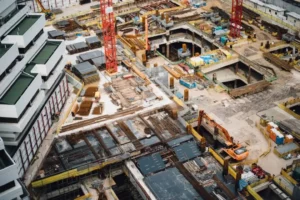Construction management software – Purpose and Benefits

All you need to know about Construction management software – Explore how scheduling software can advance you to success
Everyone is aware that construction management software is an investment of time and resources. And rightly so. Once you observe the benefits and problem-solution approach of the tool, all the effort is worth it. An integrated and comprehensive construction project management platform, such as Linarc, can be advantageous. Before we get into the benefits, let’s first capture the intent.
Basics of construction management software
Construction management software allows you to collaborate and manage multiple projects from anywhere. The platform must make organizing all your tasks effortless with real-time scheduling, resource allocation, crew assignment, dispatch, payroll, materials management, asset tracking
Construction software advantages
Connected project team
Construction projects are collaborative. A connected project team makes it easier to discuss, share ideas, raise issues, and quickly resolve on-site problems. When various sub-contractors are on different systems, it becomes a challenge to find a way to sync data and share it across teams of people.
Using construction project software solves many of these problems by providing a single platform that can integrate with many collateral product solutions in the market. It is an application that helps the construction team members, from project managers to forepersons and designers, coordinate and monitor all aspects of a construction project. The true benefit of construction software is that it connects teams while saving time and money.
Seamless data & information flow
Traditionally, construction has struggled with siloed teams. Data and people work in a metaphorical box that isolates each contractor in silos. On one side, people’s silos block communication and collaboration. On the other side, data silos impact the quality & timeliness of decisions. Here, an integrated project management software comes with the core advantage of seamless data & process flow across the extended project team.
Today, project owners are leaning toward digital managed solutions to combat siloed thinking. Team integrations with intelligent automation benefit from better progress tracking, shorter resolution times, and better decision quality. Furthermore, connected teams reduce the probability of costly delays and allow better control of quality issues.
Cloud-based document storage
Construction projects require several shared documents. Some common types are contracts, specifications, estimates, plan sheets, and records. Managing documents and their access is arduous. Cloud storage can help you set document access based on user profiles. The storage features help you efficiently organize documents and files with a comprehensive folder structure. This way, the records are readily accessible at any time. Moreover, teams can securely share the project files and documents with team members and collaborators with cloud access with no constraint of location. Cloud software provides a central storage facility that allows fruitful collaborations and inter-team knowledge sharing.
Centralized plans and drawings management
Plan sets, sheets, & drawings are the crucial design specification for any building project. A centralized project repository ensures that each team, irrespective of their location, is working on the latest sheets, not the outdated versions. Any such storage automatically processes the sheets, versions older sheets, extracts critical sheet data, and publishes them to the team. The automation features minimize the need for manual work and, more importantly, ensures correctness in ongoing work.
A fully integrated digital solution comes with the capabilities to add, modify and distribute information in real-time via various file formats. Sheet management with extensive markups and collaboration must be a cornerstone of any construction management software.
Master Schedule
Every construction project has multiple phases, contractors and stakeholders. A master schedule is the heart of a project and is the master plan for successful delivery. A typical master schedule has many components:
- A Work Breakdown Structure or WBS to spell out deliverables across different stages of the project
- A project schedule that breaks down WBS into components into tasks, milestones & checkpoints that can be scheduled, assigned to contractors & tracked.
- Contractor schedule or Field-Task schedule for each sub-contractor on the project, all connected to the master plan.
- Budget schedule or SOV that allocates the project budget to the project schedule
- Critical path schedule to focus on tasks to keep the project on track.
- Resource schedule derived from the Field Task Schedule to monitor and manage resource allocation.
- Progress schedule that tracks completion across various trades and vendors and works in tandem with critical path schedule
In addition, the scheduler should be a versatile app that is real-time, collaborative and supports contractors’ varied needs.
Real-time communication
Real-time communication means exchanging information instantly, having a direct path from one person to another. In addition to a communication channel, for construction teams, the solution must support
- Contextual information
- Cloud document storage
- In-app messaging
- Cross-team secure connection
- Audio & Video access
- Discussions, Issue resolution, specialized templates
- Links to schedule, RFI, and other workflows
In construction, real-time communication has the added benefit of minimizing risks. For example, communication between the office and field teams can get demanding. Real-time conversations improve efficiency and coordination between the companies. The in-app instant messaging feature helps collaborators, managers, team members, and workers at various locations raise queries, clarify the design, make decisions, share instructions, etc. Enabling real-time conversations among the team members helps improve accountability and eliminate communication-related errors.
Mobile timecards
Mobile timecards are indispensable for streamlining the payroll process and labor cost tracking. Mobile timecards save time, reduce cost & improve data accuracy. Management, human resources, and accounting departments use these to capture daily work hours on & off the field.
A construction timecard app can automatically capture the data accurately, saving time for employers and employees. Firstly, with timecard apps workers can daily record the time spent on the job site. With an app designed for construction, the field hours can be recorded against pre-set task codes, thereby allowing for upstream automation. Additionally, timesheet data assist businesses in tracking expenses, planning work, crew allotments for forthcoming tasks, and more. The payroll module uses this data to calculate the employees’ pay at the end of each payroll cycle.
Payroll management
Weekly payroll to field workers is the norm in the construction industry. Payroll is a multi-step process:
Computing wages:
- Compiling weekly worker timecards accurately
- Adjusting for PTO, sick leave and unpaid time off
- Adjusting for shift-based pay and overtime hours
- Understanding union rules & rates
- Computing gross pay
Distributing worker wages:
- Complying with regulatory requirements for deductions
- Direct deposits or checks to workers
There are many standard solutions available today to support worker wage distribution. Any standard app can do this well. But for computing construction wages accurately, you require a specialized solution to pull data from digital timecards and apply rules & rates. The app eliminates the excel sheets, manual steps & human error. As a result, you get better accuracy with minimal or no paperwork and swift payroll processing.
Workflow management
A construction project involves various documents and items that pass through multiple parties for successive stages from creation, review, and revision to approval and implementation in their life cycle. Examples include budget revisions, RFIs submittals, change orders, punch lists, etc. Any good construction platform must support custom workflow templates with successive stages, functional assignments, elapse times and ultimate resolution. An automated workflow management system can:
- Reduce errors and re-work
- Improve compliance with inbuilt audit trails
- Automate multi-step processes with tracking
- Identify and improve steps that cause bottlenecks
- Drastically reduce paperwork, costs and time loss
- Reduce the need for manual decision making
- Business rules-driven processes
- Measurable time & cost and associated process improvements
Budget and cost tracking
Construction projects are notorious for cost overruns. Most common reasons include changes in project circumstances, increased material & labor costs, incorrect estimation, etc. One major challenge to managing cost overrun is tracking real-time actual cost data against the budget. When cost data is siloed and/or accumulated periodically, critical daily decisions are made without guiding data. For example, imagine one of the project tasks took much longer than planned. This increases the labor cost and impacts the bottom line. If this is not assessed until the end, it could result in the project being over budget. Tracking these costs and constantly verifying against the budget can be tedious. Setting better budgets and automating how the cost is entered leads to regular cost tracking. Organic real-time cost capturing, where and when it occurs, is an effective way to manage budgets. Budget control combined with predictive risk forecasts helps to prepare risk mitigation plans. This gives project managers and CXOs the data they need to avoid scary cost overruns.
Dashboards, Reports & Predictions
A construction software platform gathers data from various modules daily. and renders them from dashboards and reports. It is equally important for the platform to represent this as meaningful information on dashboards and reports. These dashboards and reports must show critical statistics and metrics in easily digestible visual formats to aid in decision-making and spotting emerging trends. Construction dashboards must support operational teams, be predictive & help strategic decisions. By following the right guidelines, projects big or small can efficiently analyze, visualize and evaluate performance and make well-informed decisions. With a construction management software designed to support decisions, it is possible to stay ahead of project goals and resolve emerging trends before they are issues.
How to create a project schedule with construction management software?
The most challenging part of the pre construction phase is establishing a construction schedule. The schedule keeps the workforce and managers in sync through the long and complex construction projects.
While every constriction project is unique, project schedules, by and large, follow the same workflow. It is a calendar that will highly influence how successful a project is.
Here are the steps to building a project schedule.
- List out each phase of the project and the estimated time
First, create a list of the project phases and the time it will take to complete each stage. Linarc’s Master Scheduler offers a Work Breakdown Structure (WBS) to create a construction project schedule. The hierarchical method breaks down each task into subtasks and then more subtasks until all work items can be managed conveniently by the team.
- Set a calendar for the tasks
Next, put the tasks in the order they need to be completed and fix a calendar for them. Place them in parallel if some jobs are to be completed concurrently. Gantt chart is a helpful tool, which includes the phases and their respective subtasks on a timeline. It lists out the task dependencies and estimated actual start and finish dates. The Chart helps prioritize dependencies that must be completed before the next phase begins.
- Present the schedule to all stakeholders for review
Submit the schedule to all relevant stakeholders to ensure it meets the project’s overall requirements. Experts for each unit will be able to point out any oversights in the plan, such as weather complications, traffic, regulations, safety, and other factors that may affect their relevant sections of work. Construction dashboards on Linarc’s Master Scheduler give visibility of the entire schedule to the operational teams and help them be predictive to take strategic decisions.
A good project schedule ensures workers know when their section of work needs to be started and completed and the budget available for the job. As the project size grows, the number of tasks that need to be scheduled increases, and construction management software designed specifically for project scheduling becomes the need of the hour.
What do you think makes an effective construction management platform? Share your comments
Linarc’s Construction software is an all-in-one cloud-based construction management software. Book a demo session with us and take control of all your operations.




